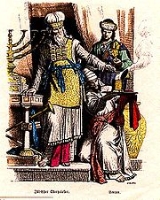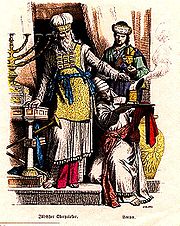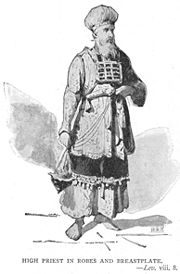
Mitznefet
Encyclopedia


Tabernacle
The Tabernacle , according to the Hebrew Torah/Old Testament, was the portable dwelling place for the divine presence from the time of the Exodus from Egypt through the conquering of the land of Canaan. Built to specifications revealed by God to Moses at Mount Sinai, it accompanied the Israelites...
and the Temple in Jerusalem
Temple in Jerusalem
The Temple in Jerusalem or Holy Temple , refers to one of a series of structures which were historically located on the Temple Mount in the Old City of Jerusalem, the current site of the Dome of the Rock. Historically, these successive temples stood at this location and functioned as the centre of...
.
Etymology
The Hebrew word mitznefet (מִצְנֶפֶת) has been translated as "mitreMitre
The mitre , also spelled miter, is a type of headwear now known as the traditional, ceremonial head-dress of bishops and certain abbots in the Roman Catholic Church, as well as in the Anglican Communion, some Lutheran churches, and also bishops and certain other clergy in the Eastern Orthodox...
" (KJV) or "headdress". It was most likely a "turban
Turban
In English, Turban refers to several types of headwear popularly worn in the Middle East, North Africa, Punjab, Jamaica and Southwest Asia. A commonly used synonym is Pagri, the Indian word for turban.-Styles:...
", as the word comes from the root "to wrap".
Hebrew Bible
The turban worn by the High Priest was much larger than the head coverings of the priests and wound so that it formed a broad, flat-topped turban, resembling the blossom of a flower. The head covering of the priests was different, being wound so that it formed a cone-shaped turban, called a migbahat.The priestly crown
Tzitz
The priestly crown or frontlet was the golden plate or tiara worn by the Jewish High Priest on his mitre or turban whenever he would minister in the Tabernacle or the Temple in Jerusalem.-Etymology:...
(Hebrew tzitz צִיץ "blossom" "flower") was attached to the turban by means of two sets of blue cords: one going over the top of the head and the other around the sides of the head at the level of the ears (Exodus 39:31).
Talmud
According to the TalmudTalmud
The Talmud is a central text of mainstream Judaism. It takes the form of a record of rabbinic discussions pertaining to Jewish law, ethics, philosophy, customs and history....
, the wearing of the turban atoned for the sin
Sin
In religion, sin is the violation or deviation of an eternal divine law or standard. The term sin may also refer to the state of having committed such a violation. Christians believe the moral code of conduct is decreed by God In religion, sin (also called peccancy) is the violation or deviation...
of haughtiness on the part of the Children of Israel (B. Zevachim 88b).
See also
- Priestly undergarments
- Priestly tunic
- Priestly sash
- Priestly robe (Judaism)
- EphodEphodAn ephod was an article of clothing, and a worship object, in ancient Israelite culture, and was closely connected with oracular practices....
- Priestly breastplate
- Priestly frontletTzitzThe priestly crown or frontlet was the golden plate or tiara worn by the Jewish High Priest on his mitre or turban whenever he would minister in the Tabernacle or the Temple in Jerusalem.-Etymology:...

